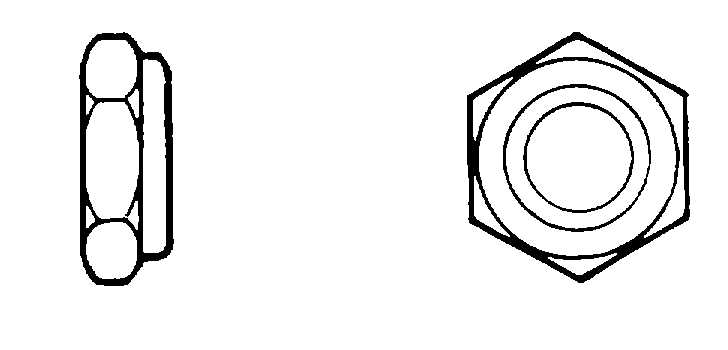TM 1-1500-204-23-6
•
Under emergency conditions, any steel bolt or screw of the same nominal diameter as the hole having a tensile
strength of 125,000 psi may be used, provided it is replaced with the correct fastener within 25 flight hours.
t.
Substitutions for Jo-Bolts and V-Bolts. These bolts can be replaced by the bolts listed in table 2-7. Jo-Bolts are
numbered in relation to their diameter. The asterisk denotes the length dash number. This type of fastener is used
primarily in blind installations.
2-3.Nuts. The following paragraphs present the various families of aircraft structural nuts, their types, means of
identification, and proper applications.
a.
Self-Locking Nuts. Self-locking nuts are used on aircraft to provide tight connections which will not shake loose
under severe vibration. These nuts must meet the critical specification as to strength, corrosion resistance, and
temperature range set forth in MIL-N- 25027 before they can be used. Standard nuts are shown in figures 2-14 and 2-15.
(1) Types. The two general type self-locking nuts currently in use are designated as the all-metal type and the
nonmetallic insert (fiber or nylon) type. Each obtains its locking quality through a different means as indicated by its
respective title.
(a) All-metal self-locking nuts. Locking action of the nut depends upon the ability of the metal to recover its
size and shape when the locking action and the load-carrying portion are engaged by bolt or screw threads. When used,
the following criteria must be met:
Table 2-7. Jo- and V-Bolt Substitution
Jo-Bolt
V-Bolt
Hole dia
part No
part No.
(inches)
WP 164
BA5A*H
0 164 to 0.168
WP 200
BA6A*H
0.199 to 0.203
WP 260
BA8A*H
0.261 to 0.265
WP 312
BA1 OA*H
0 313 to 0.317
WP 164
BA5A*F
0.164 to 0.168
WP 200
BA6A*F
0.199 to 0.203
WP 260
BA8A*F
0 261 to 0 265
WP 312
BA1 OA*F
0 313 to 0.317
•
All-metal self-locking nuts shall not be reused in critical applications where failure could cause loss of the aircraft or
endanger life.
•
When absolutely necessary, all-metal self- locking nuts may be reused in noncritical applications only, and then only
after having equalled or exceeded the minimum breakaway torque value for the applicable size nut, as given in table
2-8.
•
High temperature, MS20500 or approved equivalent, and silver-plated, all-metal, self-locking nuts will not be
subjected to temperatures in excess of 12000F (6480C).
•
Do not subject cadmium-plated, all-metal, self-locking nuts to temperatures in excess of 4500F (2320C).
•
Do not run a thread-cutting tap through an all-metallic, self-locking nut, as this will destroy the self-locking properties.
(b) Nonmetallic insert self-locking nuts. The nonmetallic fiber or nylon insert is pressed within the inside
diameter of the nut proper. When a screw or bolt is installed, the insert stretches and forces contact between itself and
the bolt or screw threads, producing the locking action. When used the following criteria must be met:
•
Nonmetallic self-locking nuts shall not be reused in critical applications where failure could cause loss of the aircraft
or endanger life.
•
When absolutely necessary, nonmetallic self-locking nuts may be reused in non- critical applications only, and then
only after having equalled or exceeded the minimum breakaway torque value for the applicable size nut, as given in
able 2-8.
Figure 2-14. Self-Locking Thin Nut
Change 1 2-25

